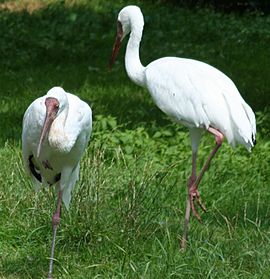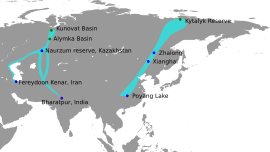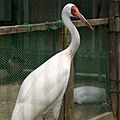Siberian crane facts for kids
Quick facts for kids Siberian crane |
|
|---|---|
 |
|
| Siberian crane | |
| Conservation status | |
| Scientific classification | |
| Kingdom: | |
| Class: | |
| Order: | |
| Family: | |
| Genus: | |
| Binomial name | |
| Grus leucogeranus |
|
 |
|
| Route used by Siberian cranes in migration | |
The Siberian crane is also known as the Siberian white crane or snow crane. Its scientific name is Grus leucogeranus. This beautiful bird is a type of crane that is in great danger. It is considered a critically endangered animal.
Siberian cranes live in three main groups. Each group travels long distances, flying from their breeding grounds to warmer places for winter. One group flies from eastern Siberia to China. Another group travels from western Siberia to India. The third group migrates from western Russia to Iran.
Contents
What Siberian Cranes Look Like
Siberian cranes are very striking birds. Adult cranes of both sexes have bright white feathers all over their bodies. The only exceptions are their wingtips, which are black. These black feathers are called primaries, alula (a small group of feathers on the wing), and primary coverts (feathers that cover the base of other feathers).
The front part of their head, including their face and the top of their head (called the fore-crown), has no feathers. This bare skin is a brick-red color. Their beak is dark, and their legs are pinkish. Siberian cranes have yellowish eyes.
Young Siberian cranes, called juveniles, look a bit different. Their faces have feathers, and their body feathers are a dull brown color. Unlike some other crane species, Siberian cranes do not have long, fancy feathers on their backs called tertial feathers.
Special Habits
During the time of year when they have their babies, both male and female Siberian cranes often have mud on their feathers. They dip their beaks into mud and then rub it onto their feathers. Scientists believe they do this to help them blend in with their surroundings.
The sound a Siberian crane makes is quite unique. Most cranes make a loud, trumpeting call. But Siberian cranes make a high-pitched, whistling sound that is more like a goose. It sounds like "toyoya."
Size and Weight
Siberian cranes are large birds. They usually weigh between 4.9 and 8.6 kilograms (about 11 to 19 pounds). They stand about 140 centimeters (55 inches) tall. Their wings can spread very wide, from 210 to 230 centimeters (about 83 to 91 inches). From head to tail, they are about 115 to 127 centimeters (45 to 50 inches) long.
Male Siberian cranes are generally a bit bigger than females. There has been one rare record of a very large male of this species that weighed 15 kilograms (33 pounds)!
Siberian Crane Groups
The Siberian crane is a migratory species, meaning it travels long distances between its breeding and wintering grounds. There are three main populations, or groups, of these cranes.
The Eastern Group
This is the largest group of Siberian cranes. It is thought to have about 3,000 to 4,000 cranes. This makes up more than 95% of all Siberian cranes in the world! In 2008, about 3,750 individual cranes were counted at Poyang Lake in China. This lake is one of their important winter homes.
These cranes spend their breeding season in the Yakutia region of northeastern Siberia. When winter comes, they fly south to the Yangtze River valley in China. Sometimes, these cranes are seen in places like Mongolia, Japan, and Korea. However, they do not breed in these areas.
The Central Group
The central group of Siberian cranes is believed to breed in western Siberia, especially near the Ob River. These cranes used to spend their winters in India.
Researchers think these cranes flew over Kazakhstan and Afghanistan to reach Keoladeo National Park in India. This idea comes from cranes being seen in Kazakhstan, and some even stopping at lakes in Afghanistan during their journey.
Sadly, the central group of cranes was last seen in 2002. At that time, there were only four cranes left. Because of this, many people believe this group may now be extinct, meaning they no longer exist in the wild.
Images for kids
See also
 In Spanish: Grulla siberiana para niños
In Spanish: Grulla siberiana para niños






